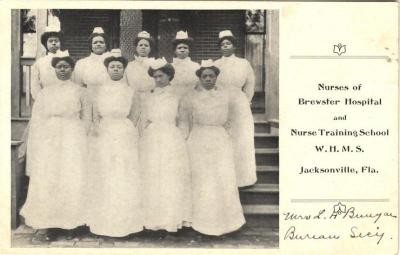February is Black History Month! |
This month we are featuring "Black History Month: A Medical Perspective," our online exhibit containing a chronology of medical achievements of African Americans, a section on folk medicine, and a selective bibliography.
Pat Thibodeau, Proactive Leader of Innovation and Mentorship
Rebecca Williams, Archives Librarian for Research, Outreach, and Education
 As Pat Thibodeau, Associate Dean for Library Services & Archives, prepares to retire at the end of March, she leaves a rich legacy of innovation, collaboration, and mentorship. During her entire career and twenty-four-year tenure at Duke, the medical and library professions have both undergone many changes and faced many challenges, yet Pat has admirably led and guided the Duke Medical Center Library & Archives into the digital age. Under her leadership, the library has pushed forward and not only survived, but also thrived and grown to become an important leader in the field.
As Pat Thibodeau, Associate Dean for Library Services & Archives, prepares to retire at the end of March, she leaves a rich legacy of innovation, collaboration, and mentorship. During her entire career and twenty-four-year tenure at Duke, the medical and library professions have both undergone many changes and faced many challenges, yet Pat has admirably led and guided the Duke Medical Center Library & Archives into the digital age. Under her leadership, the library has pushed forward and not only survived, but also thrived and grown to become an important leader in the field.
Pat first came to Duke in 1993 as Associate Director for the Library, but her work in libraries began long before then. Her passion for the field was born while volunteering in her high school library where she enjoyed all types of tasks from mimeographing catalog cards to helping out fellow students and teachers with cranky movie and filmstrip projectors. While the specific equipment has changed, Pat remains skilled at learning new technology, adapting to new challenges, and embracing new ideas.
After graduating with degrees from the University of New Hampshire and University of Rhode Island, Pat took her first professional job as a cataloger at Rhode Island College. As she gained experience in that position, her colleagues informed her of a nearby open position at the Women & Infants Hospital of Rhode Island. Pat was appointed Director of the Health Sciences Information Center and Research Administration at the hospital in 1977 where she began her career in both administration and medical libraries. While the hospital was small in terms of bed size, NIH funded research was a part of the daily operations of the institution and thus Pat was exposed to the full realm of academic medicine including residents, medical students, fellows, researchers, and experts in clinical medicine. Additionally, she was the research administrator for the IRB, which required her to coordinate the 26-member board and ensure compliance with federal regulations. Computers were a rarity at the time, but Pat used her own personal computer to create the IRB policy manual, yet another example of her embrace of new technologies and ability to proactively look ahead.
Pat eventually managed herself out of the job by successfully planning the merger of her library with the larger hospital library. She then accepted another library director position at the Mountain Area Health Education Center (AHEC) where she worked from 1983-1993. During her tenure at AHEC, personal computers were first introduced into the library, and Pat built the first computer training lab for the AHEC staff and then expanded it for health professionals. It was also during her tenure at AHEC that Pat earned her MBA degree, which has certainly benefited our Library by her deep understanding of the thought processes of administrators and the pressures with an institution.
Pat’s record prior to Duke is impressive and she certainly has built upon these professional successes during her tenure here. After arriving at Duke as Associate Director, Pat quickly assumed responsibility for most of the activities and duties of Director during the illness of the then Director. She was appointed Acting Director in 1999 and officially appointed Associate Dean for Library Services & Archives in 2000.
Pat has proactively transformed the medical library from a space dedicated to the storage of print volumes to a space devoted to the study and research needs of students and faculty. Under her direction, the library became a leader in the transition to digital libraries as the library staff dramatically reduced the print collection long before others in the field were doing the same. This is simply one example of Pat’s forward-thinking leadership. Open to new ideas, Pat more than willing to explore and support new initiatives. From successfully petitioning the hospital to adopt personal digital assistants to developing and refining the library liaison program, Pat has been active in cultivating partnerships and advancing the information goals of the Duke Medical community.
Before Pat was Director, the Medical Center Archives were a well-kept secret. She has allowed the department to grow and flourish by actively advocating for and promoting archival resources. She has been a member of an impressive number of committees and task forces which has allowed her to continue to find new opportunities and initiatives for the library to be involved in, such as the redesign of the School of Medicine curriculum, bibliometric work, and faculty publishing.
Pat also has a reputation as an authority on scholarly communications. Her understanding of the issues and processes in the academic research cycle has made her an invaluable resource to the Duke community as well as the larger scholarly community. Particularly remarkable is her leadership in compliance work on the NIH Public Access Policy. This policy requires NIH-funded researchers to deposit a version of their article manuscripts in an open access repository so that the results are freely available and not locked up in subscription only sites. Under Pat's leadership, Duke achieved a 97% compliance rate, one of the highest in the nation, preventing the loss of NIH grant funding for Duke faculty members and demonstrating to others nationally how the library can lead this important, value-based initiative at their own institutions. Her knowledge about scholarly communications has also led to her engagement with PubMed Central, the Association of Health Science Libraries (AAHSL) Scholarly Communication Committee, the Chicago Collaborative, the Joint Publishers Task Force, the MLA Task Force on Scholarly Publishing, and other national groups in this domain. As a result of this work, she received the Medical Library Association President’s Award for work in scholarly communications in 2005. More recently, the Board of Regents for the National Library of Medicine appointed her to the National Institutes of Health PubMed Central National Advisory Committee from 2011 to 2014, where she served as chair for two of those years.
On a national level, Pat has lead the profession as AAHSL President-elect, President, and Past President from 2009-2012 and Medical Library Association (MLA) President-elect, President, and Past President from 2003-2005. Contrary to what her impressive resume might suggest, Pat is someone who does not need the spotlight. Her colleagues are quick to praise her constant support, open door policy, and listening ear. She is a great mentor who trusts her employees, supports their ideas, and encourages participation.
When asked what has kept her at Duke, Pat cited presence of the constant change, opportunities for learning, and the collaborative nature of Duke. While this is undoubtedly representative of the larger Duke community, it is specifically descriptive of the Duke Medical Center Library & Archives culture as well, a culture dramatically shaped by Pat and her leadership. She has been a leader who has pushed the Library forward with calculated risks, worked with people where they are, and encouraged learning and exploration.
After retirement, Pat plans to continue to enjoy her time gardening, hiking, traveling, and spending time with her husband and their poodle. An artist who works with both glass and pottery, she will certainly have plenty of things to occupy her time, but she will still actively benefit the profession by working on the National Library of Medicine’s Strategic Planning committee.
The Medical Center Library & Archives thanks Pat for helping to set the Library’s future vision, while ensuring the very best services and resources for the present. Duke University Medical Center faculty, staff, and students have appreciated her many contributions to the Library and Medical Center. She will be missed, but thanks to her dedicated leadership, she leaves the Medical Library well poised for future success.
Exhibit: Pictures of Nursing: The Zwerdling Postcard Collection
 Currently On Display
Currently On Display
Pictures of Nursing: The Zwerdling Postcard Collection
Medical Center Library & Archives - Level 2R
On Display until February 25, 2017
The Medical Center Library & Archives is hosting "Pictures of Nursing: The Zwerdling Postcard Collection," a six-banner traveling exhibition. Developed and produced by the National Library of Medicine, it displays a unique archive of 2,588 postcards and over 100 years of images of nurses and the nursing profession from around the world.
Nurses and nursing have been the frequent subjects of postcards. These images are informed by cultural values; ideas about women, men, and work; and attitudes toward class, race, and national differences. By documenting the relationship of nursing to significant forces in 20th-century life, such as war and disease, these postcards reveal how nursing was seen during those times.
This exhibition highlights only a small selection from The Zwerdling Postcard Collection, but over 500 more are available to view in the exhibition's online digital gallery at http://nlm.nih.gov/exhibition/picturesofnursing/digitalgallery.
Broaden Your Research Impact
Megan Van Noord, Research & Education
Research takes time, dedication, and patience! After putting so much effort into acquiring funding, getting IRB approval, collecting and analyzing data, and publishing your findings, take the next step to ensure your research makes a broader impact.
How? Follow these three steps.
- Update your Scholars@Duke profile! Scholars@Duke helps local and global communities connect to Duke Scholarship.
- Create an ORCID ID! ORCID provides you with a unique identifier that distinguishes you from other researchers (very helpful for those with similar names!) and helps to identify your scholarly communications.
- Discover your research impact! Calculate your H-Index and track who has been mentioning your work in the media using Altmetrics.
The Library is here to help! Contact medical-librarian@duke.edu for questions.
Historical Materials about African Americans at Duke Medicine
This issue highlights the research guide, African American History at Duke Medicine, produced by Medical Center Archives. The guide aims to introduce researchers to materials documenting the history of African American faculty, students, and staff at Duke Medicine. Included are oral histories, archival collections, photographs, audiovisual materials, and publications, selected key dates and key figures, and links to recommended digital resources.
Weekly profiles of African Americans at Duke Medicine will also be posted on the Archives blog during this month.
 |
EndNote X8 Now Available
Jamie Conklin, Research & Education
Clarivate Analytics, formerly the Intellectual Property & Science division of Thomson Reuters, has released a new version of EndNote — version X8.
With this upgrade, you now have the ability to:
- Share your library with up to 100 people rather than the 14 allowed in version X7. Also rack member activity with an activity feed and identify which new members joined the library you shared.
- Use the "Recently Added" folder to view references added in the last 24 hours, 7 days, 14 days, or 30 days.
- Take advantage of new icons to use as shortcuts. (Unlike X7, the icons are the same for both Mac and PC users.)
See these new features in action in the video, "What's New in EndNote X8?"
If you are ready to upgrade, we recommend you follow these steps:
- Compress your current X7 library as a backup copy
- Download X8 from the OIT Website
- Uninstall X7
For more information or for help in using EndNote, check out our Reference Management Guide or Ask a Librarian!
Global Impact Using Scopus
Virginia Carden, Administrative Research Librarian
Have you ever wondered about your publications and their global impact? If the answer to this is yes, here’s a way to see the information.
- Choose Scopus from the Databases, Journals & Books section of our Website.
- Once you are in Scopus, click on the tab for Author Search, type in your name, and click Search. You will then be taken to a list of authors with the first and last name you typed in.
- Select all the author profiles that are you (or the person you wish to see) and click Show documents in the bar above the name.
- Click the "All" check box just above the first citation and then choose View citation overview. You will now be looking at the articles which cite you or the author you are seeking.
- Choose the View Cited by link above the first reference and then click the "All" check box.
- Choose the Analyze search results link above and to the left of the first citation.

- You can then view documents by Country/Territory which includes a color bar chart of up to 15 countries/territories (depending on the number you check). If you wish to create a chart with the entire list, highlight the list of countries/territories (with document count) on the left and copy them into Excel.
- Other types of analysis include by Year, Source, Author, Affiliation, Document type, and Subject area.
New Haas Books
Barbara Dietsch, Acquisitions & Cataloging Manager, Collection Services
Here are a few of our new books purchased with a gift from the estate of Dr. William Reid Haas and Mrs. Ardelle B. Haas.
Jane Brooks and Hallett Christine
This book examines the work that nurses in many different nations undertook during the Crimean War, Boer War, Spanish Civil War, both World Wars, and the Korean War. It makes an excellent and timely contribution to the growing discipline of nursing wartime work. In its exploration of multiple nursing roles during the wars, it considers the responsiveness of nursing work, as crisis scenarios gave rise to improvisation.
Christine E. Hallett
Although allied nurses were admired in their own time for their altruism and courage, their image was distorted by the lens of popular mythology. They came to be seen as self-sacrificing heroines, romantic foils to the male combatant and doctors' handmaidens, rather than being appreciated as trained professionals performing significant work in their own right. Hallett challenges these myths to reveal the true story.
Edited by Gerard M. Fealy, Christine E. Hallett, and Susanne Malchau Dietz
This book examines the history of nursing practice in Europe and North America. It differs from most other studies of nursing history by focusing on the actual clinical work of nurses. It explores two broad categories of nursing work: the "hands-on" clinical work of treatment and care; and the work of health screening, health education and public health crisis management.
Emily Mayhew
Drawing on hundreds of letters and diary entries, Mayhew tells the history of the Western Front from a new perspective: the medical network that arose seemingly overnight to help sick and injured soldiers. These men and women pulled injured troops from the hellscape of trench, shell crater, and no man's land, transported them to the rear, and treated them for everything from foot rot to poison gas.
Suggestions for purchases? Complete our online Recommend a Purchase form or contact Emma Cryer Heet. For a complete list of titles added to our print book collections within the last 3 months, check out the Library's newest print book additions or subscribe to our "New Books" feed.
Improve Your Library Research Skills!
The Medical Center Library offers training on a variety of topics. Request a session for yourself or a group, schedule an appointment for a research consultation, or register for a class.
Publication Schedule & Staff
Duke University Medical Center Library & Archives News is published bimonthly.
| Pat Thibodeau, Associate Dean | Beverly Murphy, Editor |
| Editorial Board: | |
| Jamie Conklin | Barbara Dietsch |
| Megan von Isenburg | Rebecca Williams |
Subscribe to our newsletter and be notified when a new issue is published!




